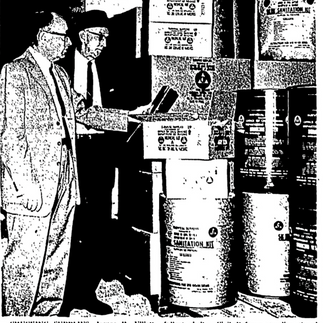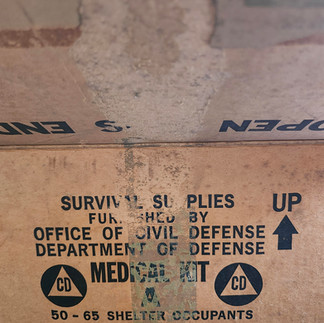Cold War Bites: Fallout Shelter Cuisine
- kellison71
- Sep 13, 2024
- 3 min read
In honor of the new Spies and Space: Toys of the Cold War exhibit that opened in Centennial Hall yesterday, the Castle Test Kitchen has taken a turn into the fabulous foods of the Cold War Era. (Of course, you already know, we love a good Jello mold!). Our exploration led us down a rather disturbing, yet interesting, rabbit hole—how to prepare proper cuisine when stuck in your fallout shelter—what every good housewife should know.

Taking Shelter
After WWII ended in 1945, there was a worldwide rush to collect uranium and plutonium ore for the production of not just nuclear weapons, but “products of peace,” like nuclear-powered ships, submarines, nuclear power in general, and more. In fact, President Dwight Eisenhower had a whole Atoms for Peace platform in the 1950s where he outlines the peaceful uses of atomic power. Suffice it to say, Americans and Soviets were really jazzed about atomic energy—no matter its eventual use.
By the 1960s, the cultural tides surrounding atomic energy had shifted as the Cold War began to heat up with incidents like the Berlin Crisis and the Cuban Missile Crisis. As it turns out, Americans didn’t particularly care for being on the brink of nuclear war and the Federal Government began to prep for this eventual (and admittedly horrific) end. Widespread fallout shelters and the promotion of personal fallout shelters were part of this trend.

In 1961, Congress voted to spend $169 million on a nationwide program of fallout shelters to protect mass population numbers from radioactive fallout in the case of nuclear attack. These efforts included selecting and fortifying building locations in major cities, like Saginaw, and stockpiling them with supplies to last a minimum of 2-3 weeks based on the number the shelter would protect.
These fallout shelters, which included the Castle building, and 92 other facilities county-wide, were designated with a visually jarring black and yellow sign that was easily identifiable by up to 200 feet away. Saginaw’s shelter system, monitored by the Civil Defense Department and its local volunteers, would have theoretically held 66,836 people—for a county-wide population of around 220,000 by the late 1960s.

Even though Saginaw was serious about nuclear attack (even hoping to put an emergency operations center in the then-proposed downtown civic center to gain federal funding for the project), the numbers didn’t lie. If people were to save themselves in the case of radioactive fallout—many would need their own personal fallout shelters at home.
A Fallout Shelter Housewife
While the mass fallout shelters would have been supplied with biscuits, a medical kit, sanitation cartons, and more, based on federal supplies and funding—all of which would be restocked every so many years when supplies expired—fallout shelters at home were entirely supplied (and built) by the families intending to use them.
October 24, 1965, Saginaw News image of restocking of fallout shelter supplies. Medical kit from a fallout shelter.
Naturally, the Federal Government had a list of suggested home fallout shelter supplies, sustainable for at least 2 weeks, but they left no further details on how to prepare food while interred below ground. Thankfully, the cult of the “fallout shelter housewife” arose, offering tasty meals prepared with just those supplies available to a family trapped in a fallout shelter.

The Castle Test Kitchen stumbled upon one of these columns and thought we’d try our hand at making fallout shelter fare, palatable.
The Recipe: Deviled Ham Spread

In a September 7, 1961 column Marie Adams, then food editor of the Charlotte News, offered suggestions for fallout shelter meals that included deviled ham and parsley dip served with tomato juice, Swedish fruit soup with cheeses, and vichyssoise with crackers, because she believed that nuclear war shouldn’t stop a “fallout shelter housewife” from providing her family with quality meals.*
Ingredients:

1 can (4.5 oz) deviled ham
1 can (4 oz) mushrooms, stems and pieces, drained and chopped
¼ C. mayonnaise
¼ t. Tabasco sauce
¼ C. dehydrated parsley flakes**
Saltine Crackers
Blend together all ingredients. Spread on crackers.
According to Adams, “Even a fallout shelter housewife--with plenty of time on her hands for once--can make a spread for crackers that will have both eye and appetite appeal.”

*Of course, Adams took some ribbing for focusing more on food quality than survival in the case of a true nuclear attack—but by the 1970s, the attitude of the country would be much more tongue-in-cheek regarding fallout shelters with the federal government even discontinuing its fallout shelter program. Most of the signs designating shelters were removed and mass shelter supplies were left to rot.
**Adams noted that the real recipe called for chopped watercress, but since fresh vegetables would not have been an option in a fallout shelter, “dehydrated parsley would serve as a good substitute.”


















